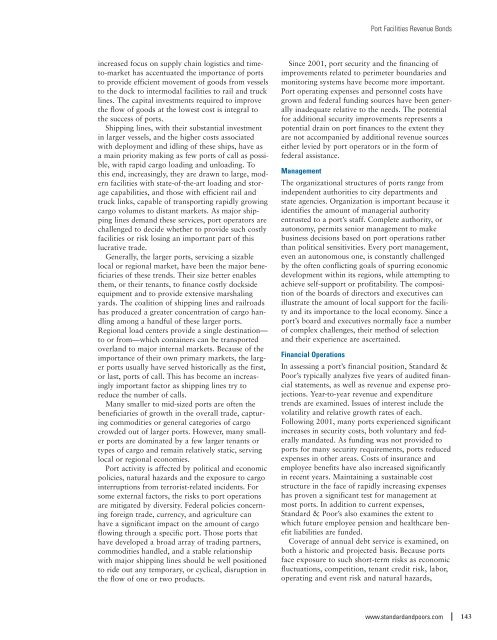S&P - Public Finance Criteria (2007). - The Global Clearinghouse
S&P - Public Finance Criteria (2007). - The Global Clearinghouse
S&P - Public Finance Criteria (2007). - The Global Clearinghouse
Create successful ePaper yourself
Turn your PDF publications into a flip-book with our unique Google optimized e-Paper software.
Port Facilities Revenue Bondsincreased focus on supply chain logistics and timeto-markethas accentuated the importance of portsto provide efficient movement of goods from vesselsto the dock to intermodal facilities to rail and trucklines. <strong>The</strong> capital investments required to improvethe flow of goods at the lowest cost is integral tothe success of ports.Shipping lines, with their substantial investmentin larger vessels, and the higher costs associatedwith deployment and idling of these ships, have asa main priority making as few ports of call as possible,with rapid cargo loading and unloading. Tothis end, increasingly, they are drawn to large, modernfacilities with state-of-the-art loading and storagecapabilities, and those with efficient rail andtruck links, capable of transporting rapidly growingcargo volumes to distant markets. As major shippinglines demand these services, port operators arechallenged to decide whether to provide such costlyfacilities or risk losing an important part of thislucrative trade.Generally, the larger ports, servicing a sizablelocal or regional market, have been the major beneficiariesof these trends. <strong>The</strong>ir size better enablesthem, or their tenants, to finance costly docksideequipment and to provide extensive marshalingyards. <strong>The</strong> coalition of shipping lines and railroadshas produced a greater concentration of cargo handlingamong a handful of these larger ports.Regional load centers provide a single destination—to or from—which containers can be transportedoverland to major internal markets. Because of theimportance of their own primary markets, the largerports usually have served historically as the first,or last, ports of call. This has become an increasinglyimportant factor as shipping lines try toreduce the number of calls.Many smaller to mid-sized ports are often thebeneficiaries of growth in the overall trade, capturingcommodities or general categories of cargocrowded out of larger ports. However, many smallerports are dominated by a few larger tenants ortypes of cargo and remain relatively static, servinglocal or regional economies.Port activity is affected by political and economicpolicies, natural hazards and the exposure to cargointerruptions from terrorist-related incidents. Forsome external factors, the risks to port operationsare mitigated by diversity. Federal policies concerningforeign trade, currency, and agriculture canhave a significant impact on the amount of cargoflowing through a specific port. Those ports thathave developed a broad array of trading partners,commodities handled, and a stable relationshipwith major shipping lines should be well positionedto ride out any temporary, or cyclical, disruption inthe flow of one or two products.Since 2001, port security and the financing ofimprovements related to perimeter boundaries andmonitoring systems have become more important.Port operating expenses and personnel costs havegrown and federal funding sources have been generallyinadequate relative to the needs. <strong>The</strong> potentialfor additional security improvements represents apotential drain on port finances to the extent theyare not accompanied by additional revenue sourceseither levied by port operators or in the form offederal assistance.Management<strong>The</strong> organizational structures of ports range fromindependent authorities to city departments andstate agencies. Organization is important because itidentifies the amount of managerial authorityentrusted to a port’s staff. Complete authority, orautonomy, permits senior management to makebusiness decisions based on port operations ratherthan political sensitivities. Every port management,even an autonomous one, is constantly challengedby the often conflicting goals of spurring economicdevelopment within its regions, while attempting toachieve self-support or profitability. <strong>The</strong> compositionof the boards of directors and executives canillustrate the amount of local support for the facilityand its importance to the local economy. Since aport’s board and executives normally face a numberof complex challenges, their method of selectionand their experience are ascertained.Financial OperationsIn assessing a port’s financial position, Standard &Poor’s typically analyzes five years of audited financialstatements, as well as revenue and expense projections.Year-to-year revenue and expendituretrends are examined. Issues of interest include thevolatility and relative growth rates of each.Following 2001, many ports experienced significantincreases in security costs, both voluntary and federallymandated. As funding was not provided toports for many security requirements, ports reducedexpenses in other areas. Costs of insurance andemployee benefits have also increased significantlyin recent years. Maintaining a sustainable coststructure in the face of rapidly increasing expenseshas proven a significant test for management atmost ports. In addition to current expenses,Standard & Poor’s also examines the extent towhich future employee pension and healthcare benefitliabilities are funded.Coverage of annual debt service is examined, onboth a historic and projected basis. Because portsface exposure to such short-term risks as economicfluctuations, competition, tenant credit risk, labor,operating and event risk and natural hazards,www.standardandpoors.com143
















